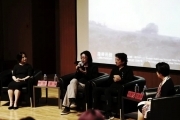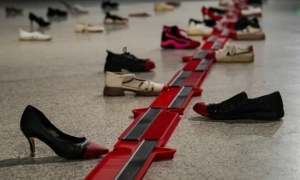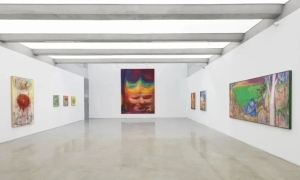第一单元:绝对原则(1983—1989)
Section One: Absolute Principles (1983 – 1989)
在“绝对原则”时期(1983—1989),寻找中国文化的整体解答方案是艺术思考的中心课题,柏拉图-黑格尔式的形而上学的宇宙论模式、尼采的超人哲学、卢梭的新权威主义的和雅斯贝尔斯、海德格尔的存在主义混合熔炼出了“北方寒带文明”这种浪漫主义的文化 方案,而中世纪教堂的造型理念、籍里柯的“形而上绘画”和蒙德里安的“新造型主义”则孕育出了“理性绘画”这种抽象冷峻的视觉匹配形式(《无穷之路》、《绝对原则》 、《涉向彼岸》),由于这一绘画理论正好契合了80年代启蒙主义的时代需求,它成为 ’85新潮美术运动的主流性绘画思潮,按艺术家自己的说法,“理性绘画”完成了中国绘画由“情态写作”向“意态写作”的转向。
In the “absolute principles” period (1983 – 1989), the search for a universal key to Chinese culture serves as the central topic of artistic thinking. The Platonic/Hegelian metaphysical model, Nietzsche’s superman philosophy, Rousseau’s revision of political authority and the existentialism of Jaspers and Heidegger came together to form the romanticist cultural manifesto known as the “Northern Frigid Zone Civilization”(Beifang Handai Wenming); the plastic concepts of medieval churches, the “metaphysical painting” of Géricault, and Mondrian’s “neo-plasticism” gave birth to the abstract and cold visual forms of “rational painting” seen in works such as Endless Road, Absolute Principles and Wading Towards the Opposite Shore. Since this theory of painting fits the criteria of the 1980s enlightenment, it became a mainstream school of thought during the ’85 New Wave movement. According to the artist, “rational painting” completed the shift in Chinese painting from “mood composition” to “manner composition”.
第二单元:走出崇高(1990—2004)
Section Two: Out of the Sublime (1990-2004)
从1990年开始将近十四年的“走出崇高”时期(1990—2004)是舒群“理性主义”艺术履历的反题阶段,他自己称为“神圣的下降”。随着90年代中国现代艺术运动的退潮和传统人文主义在新的文化场景中(主要是后现代解构思潮和消费主义的文化现实)遭遇的困境,促使舒群进入到他的“理性主义”的修正阶段,对逻辑实证主义、语言分析哲学和批判理性主义甚至解构主义的阅读,使他的思想履历发生了重大变化,分析哲学和科学哲学对传统人文主义批判的理论意义和政治意义促使他开始关注话语与话语情境的现实联系,按他自己的说法:他已由一个存在主义者转变为一个实证主义者进而转变成为一个结构主义者。这种思想转变体现在艺术上出现了分析性甚至波普主义的语言图式(《绝对原则消解》、《同一性语态——宗教话语秩序》、《同一性语态——一种后先锋主义》、《四项基本运算》、《文化POP崔健》、《世界美术全集》),这些作品意味着“由《绝对原则》这种意识形态修饰向《同一性语态》这种零度修饰的转移”,但所有变化并没有改变他的“理性主义”的理想色彩和宏观思维模式,“绝对原则”这一思想正题阶段就在1994年“向崇高致敬”这种表演性的宣示中落幕,他称这一时期是由“意态写作”向“语态写作”、文化批判向语言批判的转向时期。
The roughly decade-long “out of the sublime” period (1990-2004) marked the antithetical phase in Shu Qun’s “rationalist” art career. He calls it the “fall of the sacred”. The retreat of the Chinese modern art movement in the 1990s and the conundrum faced by classical humanism in the new cultural setting (mainly the postmodern deconstruction trend and consumer culture) sent Shu Qun into a phase of revision on his “rationalism”. Readings into logical positivism linguistic analytical philosophy, critical rationalism and even deconstructionism led to massive changes in his thinking. The theoretical and political significance of criticisms of traditional humanism by analytical philosophy and the philosophy of science led him to focus on the connections between discourse and discursive circumstances. In his words, he moved from being an existentialist to being a positivist and then a structuralist. This change in thinking was embodied in his art through the emergence of analytical, even pop linguistic composition. Works such as The Dispersal of Absolute Principals, Voices of Identity – Order of Religious Discourse, Voices of Identity – Post-Vanguard Doctrine, Four Basic Operations, Cultural Pop Cui Jian and World Art Anthology implied “a shift from the ideologically embellished Absolute Principles to the wholly unembellished Voices of Identity”, but all of these changes did not change his “rationalist” leanings or macroscopic mode of thinking; the main phase of his “absolute principles” thinking came to a close with the demonstrative performance of “a tribute to the sublime” in 1994. He calls this period one of transition from “mood composition” to “vocal composition”, a shift from cultural criticism to linguistic criticism.
相关链接:
OCAT2009年第一个大型个展“图像的辩证法:舒群的艺术”开幕现场
从单纯形而上学的思维路径上的这种出走,不仅源于对政治波普和玩世思潮这类“肤浅的认识论无政府主义”的深深失望,更源于对“理性主义”这种古典人文主义理想立场的自省和反思,在对法兰克福新马克思主义的批判理论实践、福柯话语理论和德里达解构主义的研究中,宏观性、整体性的古典理想主义暴露出意识形态上极权主义的思想本质,他的艺术也因这种理论思维的变化而进入到个人理想主义的微观生活实践,这成为他走出“理性主义”这种抽象思维的一次精神逾越和解放,在将近八年时间里他甚至放弃了绘画,从事经营、设计和参与民间美术馆的建设,理论阅读也由哲学扩展到管理学和设计史,直到2002年,“回归原初经验的冲动”和对知识考古学的兴趣才使他重新创作了《单色工农兵》和《红色毛泽东》这类具有表现主义风格的作品,而正是这一反题过程使舒群的艺术思考完成了由本体论、认识论向语言学的转移。
This departure from pure metaphysical modes of thinking was not solely due to the artist’s profound disappointment with the “superficial epistemological anarchism” of political pop and cynical realism. In fact, it was more the result of introspection and rethinking of the classical humanist standpoints of “rationalism”. Research into the neo-Marxist critical theory of the Frankfurt School, Foucault’s discourse theory and Derrida’s deconstructionism had revealed the ideological totalitarian nature of universal, unitary classical idealism, and because of these changes in thinking in theory, his art entered into the microscopic living practice of individual idealism, something that became a spiritual transcendence and liberation in his move from the abstract ideas of “rationalism”. In the nearly eight years that followed, he even gave up on painting, taking part instead in the design and operation of private museums. His theoretical reading also expanded from philosophy into management and design history. This lasted until 2002, when the “impulse to return to original experience” and an interest in the archaeology of thought led him to create somewhat expressionist works such as Monotone Workers Peasants and Soldiers, and Red Mao Zedong, and it was this antithetical process that completed the shift in Shu Qun’s artistic thinking from ontology and epistemology to linguistics.
第三单元:象征秩序(2005—2009 )
Section Three: The Symbolic Order
2005年以后对以“符号秩序”为特征的消费文化现实的思考使舒群的艺术获得了一个返归形而上之途的理由,也使他的艺术进入到“象征秩序”时期(2005—2009),重新思考“理性主义”的现实批判价值。这一阶段的作品《象征的秩序》从图式上看是对“绝对原则”时期的复制,但所针对的问题却由构筑抽象的文化模式转移到具体的“社会批判”,它正好构成了舒群“理性绘画”的一个合适的合题:重新思考中国现代化的历史遭遇,以及面对这种遭遇时所必需的理性对策,当然,和第一阶段一样,在“象征秩序”中舒群艺术所营造的问题逻辑仍然具有明显的“图像乌托邦”的特征。
Beginning in 2005, thoughts about consumer culture marked by the “symbolic order” gave Shu Qun’s art a reason to return to the metaphysical path, and brought his art into the “symbolic order” period (2005 – 2009), where he engaged in a rethinking of the value of “rationalism”in forming a critique of reality. Works from this period, such as The Symbolic Order, were in terms of image form, a replication of the “absolute principles” period, but the issue it was directed at changed from the construction of an abstract cultural model to specific “social criticism”, which made for a suitable synthesis of Shu Qun’s “rational painting”: a rethinking of the historical pitfalls of Chinese modernization and the rational countermeasures required in facing these pitfalls. Of course, just as in the first phase, the logic created in Shu Qun’s art during the “symbolic order” period was clearly marked by characteristics of “image utopianism”.
“图像的辩证法:舒群的艺术”展以“绝对原则”、“走出崇高”和“象征秩序”三个单元全面展示舒群艺术的历史脉络和思想逻辑,展览将展出舒群在这三个阶段中近五十幅代表性作品,它既是对舒群艺术的一次个案研究,也是对中国上世纪80年代以来当代艺术思想历程的一种学术整理。
The exhibition “Image Dialectic: The Art of Shu Qun” is comprised of three sections, “Absolute Principles”, “Out of the Sublime” and “The Symbolic Order”, which will give a comprehensive presentation of the historical path and rationale of Shu Qun’s art. The exhibition will include nearly 50 representative works from Shu Qun’s three phases. This is both a case study on Shu Qun’s art and an academic revision of the history of contemporary art thinking in China since the 1980s.
相关链接:
图像的辩证法:舒群的艺术
OCAT2009年第一个大型个展“图像的辩证法:舒群的艺术”开幕现场
【编辑:张瑜】
























